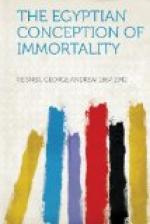The kernel of the story appears to be this: Osiris is the god of the earth, and his life is the life of the vegetation, dying and reviving with the course of the seasons, mourned by his wife Isis and succeeded by his son Horus, the sun-god. It is apparently a form of the common Tammuz or Adonis story of the Semites. This fact brings with it a suggestion which requires consideration.
The racial connection of the Egyptians may seem to have little to do with immortality. But I beg a moment’s consideration. The two great dominating ideas of immortality are those held by the Christians and by the Mohammedans, and these are essentially the same idea. Both these religions are creations of the Semitic race. It is, therefore, decidedly of importance to find that the Egyptian race, the creator of a third great religion, has also a large Semitic strain. In fact, the investigations of the last ten years appear to show that this Semitic strain it was which gave the Egyptian race its creative power and made possible the development of the Egyptian civilization.
The Egyptian language furnishes us with indisputable proof of the Semitic affinity, as Professor Adolf Erman showed years ago. The anatomical examination by Professor Elliot Smith of a large number of skeletons, dated by careful excavations, has given us a further clue. There is a prehistoric race found in the earliest cemeteries—neither Negroid nor Asiatic in characteristics. In the late predynastic and the early dynastic periods, when the great development began, this primitive race had become modified by an infiltration of broad-headed people from the north. In the Old Empire, this broad-headed people had become predominant, and remain so throughout all Lower and Middle Egypt until the present day. This intruding race, whose advent marks the beginning of Egyptian civilization, I believe to have been Semitic.
Remember this—the texts show clearly older ideas in conflict with the Osiris belief. The primitive race was not, I believe, a race of Osiris followers. Professor Erman has stated that the Osiris belief is as early as 4200 B.C. That I am certain is absolutely untenable. It is a question of Egyptian chronology in which I beg to differ radically both from Eduard Meyer and Professor Erman. In the formal calendar year of three hundred and sixty-five days, there are twelve months of thirty days and five intercalary days. These intercalary days are called the birthdays of Osiris, Horus, Seth, Isis, and Nephthys—the five most important figures in the Osiris myth. According to Professor Meyer and Professor Erman, this formal calendar was introduced in 4200 B.C., one of the occasions when the heliacal rising of the star Sothis fell on the first of the month Thoth of the calendar. However, if we accept with them the date 3300 B.C. as the date of the First dynasty, then in 4200 B.C. the Egyptians were just emerging from a neolithic state. They




